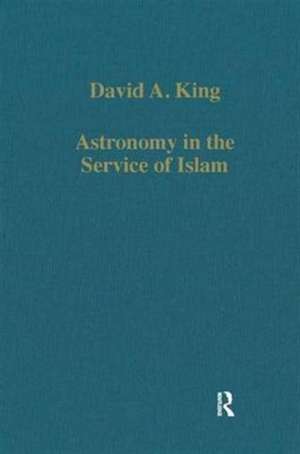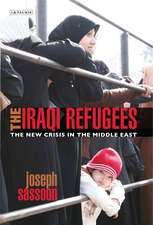Astronomy in the Service of Islam: Variorum Collected Studies
Autor David A. Kingen Limba Engleză Hardback – 25 noi 1993
Din seria Variorum Collected Studies
- 9%
 Preț: 938.85 lei
Preț: 938.85 lei -
 Preț: 311.41 lei
Preț: 311.41 lei -
 Preț: 351.48 lei
Preț: 351.48 lei -
 Preț: 313.38 lei
Preț: 313.38 lei -
 Preț: 386.77 lei
Preț: 386.77 lei -
 Preț: 325.68 lei
Preț: 325.68 lei -
 Preț: 396.00 lei
Preț: 396.00 lei -
 Preț: 312.75 lei
Preț: 312.75 lei - 9%
 Preț: 1041.23 lei
Preț: 1041.23 lei -
 Preț: 258.66 lei
Preț: 258.66 lei -
 Preț: 299.55 lei
Preț: 299.55 lei - 9%
 Preț: 938.08 lei
Preț: 938.08 lei -
 Preț: 343.33 lei
Preț: 343.33 lei -
 Preț: 311.18 lei
Preț: 311.18 lei - 9%
 Preț: 937.13 lei
Preț: 937.13 lei -
 Preț: 341.55 lei
Preț: 341.55 lei -
 Preț: 320.00 lei
Preț: 320.00 lei - 34%
 Preț: 764.20 lei
Preț: 764.20 lei - 22%
 Preț: 312.43 lei
Preț: 312.43 lei - 34%
 Preț: 739.65 lei
Preț: 739.65 lei - 34%
 Preț: 764.20 lei
Preț: 764.20 lei - 34%
 Preț: 680.73 lei
Preț: 680.73 lei - 26%
 Preț: 247.40 lei
Preț: 247.40 lei - 34%
 Preț: 485.78 lei
Preț: 485.78 lei - 34%
 Preț: 764.20 lei
Preț: 764.20 lei - 34%
 Preț: 767.07 lei
Preț: 767.07 lei - 34%
 Preț: 764.20 lei
Preț: 764.20 lei - 34%
 Preț: 769.51 lei
Preț: 769.51 lei - 34%
 Preț: 764.20 lei
Preț: 764.20 lei - 34%
 Preț: 826.68 lei
Preț: 826.68 lei - 25%
 Preț: 225.28 lei
Preț: 225.28 lei - 25%
 Preț: 225.54 lei
Preț: 225.54 lei - 34%
 Preț: 736.38 lei
Preț: 736.38 lei - 34%
 Preț: 738.43 lei
Preț: 738.43 lei - 25%
 Preț: 226.52 lei
Preț: 226.52 lei - 33%
 Preț: 491.66 lei
Preț: 491.66 lei - 34%
 Preț: 485.78 lei
Preț: 485.78 lei - 34%
 Preț: 485.78 lei
Preț: 485.78 lei - 36%
 Preț: 739.17 lei
Preț: 739.17 lei - 38%
 Preț: 766.34 lei
Preț: 766.34 lei - 31%
 Preț: 473.94 lei
Preț: 473.94 lei - 18%
 Preț: 807.71 lei
Preț: 807.71 lei - 38%
 Preț: 774.91 lei
Preț: 774.91 lei - 34%
 Preț: 764.20 lei
Preț: 764.20 lei - 34%
 Preț: 764.20 lei
Preț: 764.20 lei - 51%
 Preț: 485.78 lei
Preț: 485.78 lei - 34%
 Preț: 485.78 lei
Preț: 485.78 lei - 34%
 Preț: 769.10 lei
Preț: 769.10 lei - 34%
 Preț: 766.65 lei
Preț: 766.65 lei - 18%
 Preț: 1019.01 lei
Preț: 1019.01 lei
Preț: 736.38 lei
Preț vechi: 1112.19 lei
-34% Nou
Puncte Express: 1105
Preț estimativ în valută:
140.91€ • 147.79$ • 117.30£
140.91€ • 147.79$ • 117.30£
Carte tipărită la comandă
Livrare economică 01-15 aprilie
Preluare comenzi: 021 569.72.76
Specificații
ISBN-13: 9780860783572
ISBN-10: 086078357X
Pagini: 352
Dimensiuni: 150 x 224 x 27 mm
Greutate: 0.45 kg
Ediția:1
Editura: Taylor & Francis
Colecția Routledge
Seria Variorum Collected Studies
Locul publicării:Oxford, United Kingdom
ISBN-10: 086078357X
Pagini: 352
Dimensiuni: 150 x 224 x 27 mm
Greutate: 0.45 kg
Ediția:1
Editura: Taylor & Francis
Colecția Routledge
Seria Variorum Collected Studies
Locul publicării:Oxford, United Kingdom
Cuprins
Contents: Preface: General Survey: Science in the service of religion: the case of Islam; Lunar Crescent Visibility and the Regulation of the Islamic Calendar: Some early Islamic tables for determining lunar crescent visibility; Ibn Yunus on lunar crescent visibility; Lunar crescent visibility predictions in medieval Islamic ephemerides; Astronomical Timekeeping and the Regulation of the Times of Islamic Prayer: Mikat: astronomical timekeeping; Universal solutions in Islamic astronomy; Universal solutions to problems of spherical astronomy from Mamluk Egypt and Syria; Mizwala; The Sacred Direction in Islam: Kibla: sacred direction; Makka: as the centre of the world; Matla’: astronomical rising-points; On the orientation of the Ka’ba; Astronomical alignments in medieval Islamic religious architecture; The earliest Islamic mathematical methods and tables for finding the direction of Mecca; Addenda; Indexes.
Notă biografică
David A. King is Emeritus Professor of History of Science, Johann Wolfgang Goethe University, Frankfurt am Main, Germany
Descriere
Based on a wide variety of previously unstudied sources, these articles explain how science was applied to three aspects of Islamic ritual in the Middle Ages: the regulation of the lunar calendar; the organisation of the times of the five daily prayers; and the determination of the sacred direction (qibla) towards the Kaaba in Mecca.

















